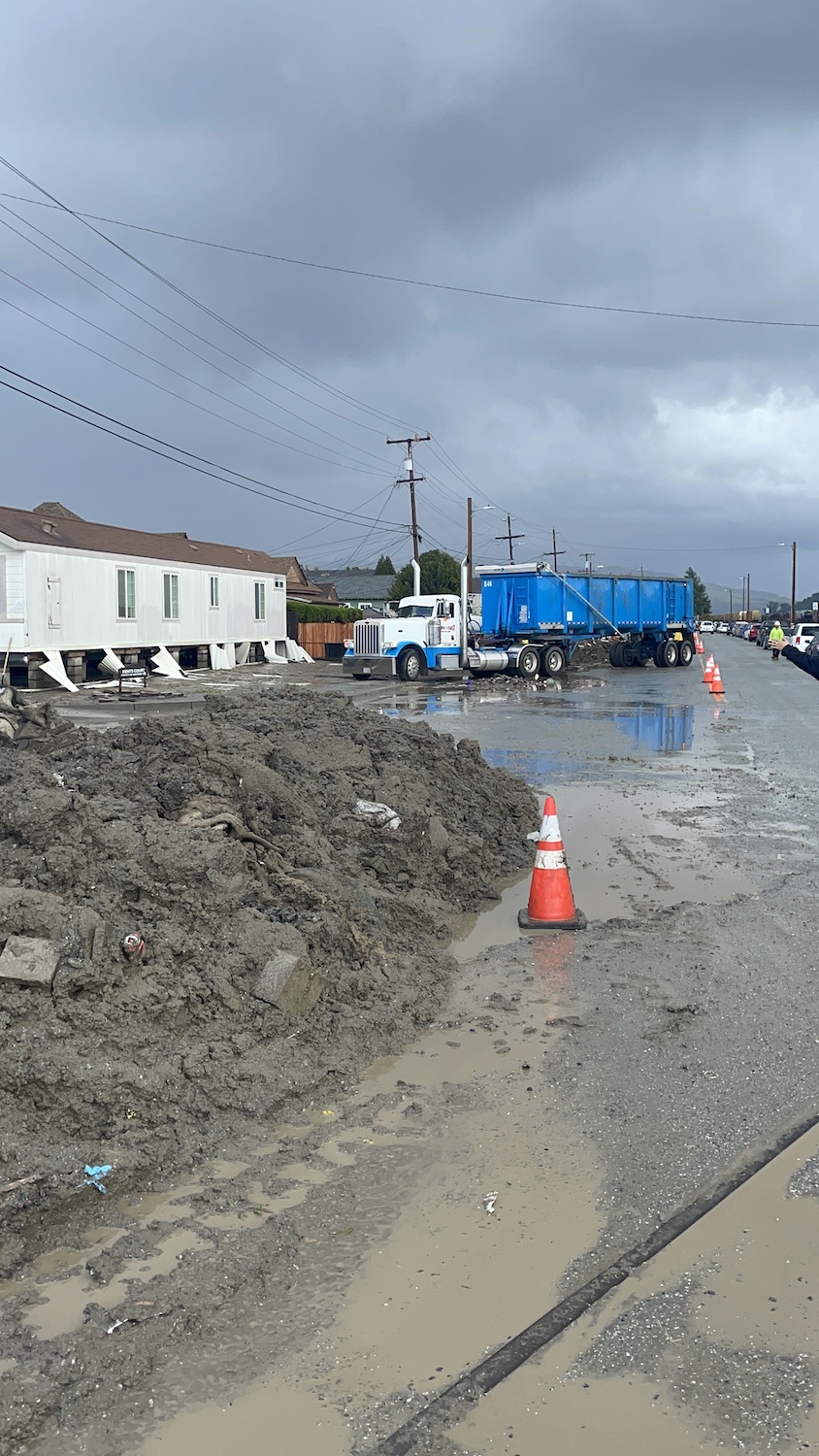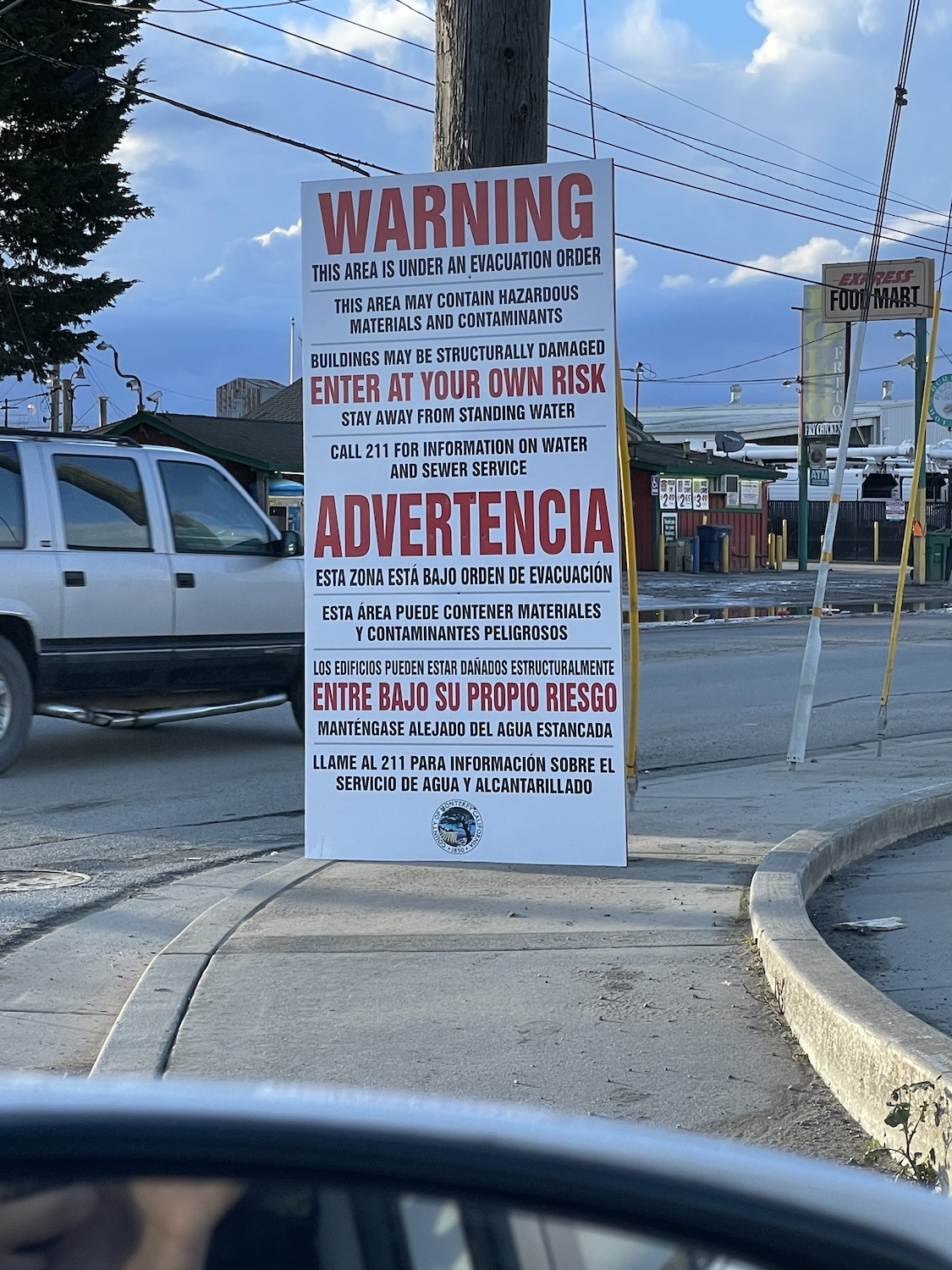
Coalition for Humane Immigrant Rights of Los Angeles members attend a climate change protest. (Image courtesy of the Coalition for Humane Immigrant Rights of Los Angeles.)
"Nos sentimos como los olvidados," or "We feel like the forgotten ones," is the sentiment expressed by residents of Pajaro, California. The community is systematically underfunded, underdeveloped and ignored. A lack of funding for infrastructure and upkeep led to a levee break that flooded Pajaro last year, Vladimir Carrasco, the deputy director of external affairs at the Coalition for Humane Immigrant Rights of Los Angeles (CHIRLA), told TriplePundit.
Worse yet, government officials knew the levee could fail, the Los Angeles Times reports. One of the reasons the repairs met long delays was because “it’s a low-income area. It’s largely farmworkers that live” in the community, an unnamed official told the news outlet.
CHIRLA is a part of a network of climate refugee and immigrant rights organizations fighting for those most impacted by the climate crisis called the Climate Justice Collaborative. The organization faces an uphill battle as it advocates for recovery funding for Pajaro.

A slow response to aging infrastructure
The response to the flood and its aftermath wasn’t any better. “When the flooding did happen, community members were warned by fire trucks at two or three in the morning — in English only,” Carrasco said. This was hardly an effective strategy considering that Pajaro is home to a majority Mexican immigrant population, many of whom only speak Indigenous languages like Mixteco.
“A well-resourced community would have had some alert system and language accessibility and a lot more than just the fire department doing outreach to community members for evacuation,” Carrasco said.
It wasn’t just the local and state governments that failed the people of Pajaro, the federal government was also slow to respond. Whereas the Federal Emergency Management Agency (FEMA) and other agencies were quick to bring services to nearby Spreckels, California, when it flooded a few months prior, Pajaro residents had to depend on local nonprofits like CHIRLA for assistance and advocacy.
The rapid response for other communities wasn’t a one-off. “Up the road from Pajaro is Santa Cruz,” Carrasco said. “Santa Cruz had been recently hit by some disaster or climate impact, and their recovery happened quite rapidly, while Pajaro was ignored for months. So the community certainly feels like this has been an unjust amount of time.”
Government officials appeared to be dragging their feet at every step. The weather conditions that brought the heavy rains and flooding that culminated in the levee break on March 11, 2023, began on February 21. Emergencies are often declared within a matter of days, but in this instance, the President Joe Biden didn’t sign the Major Disaster Declaration until the evening of April 3, and a temporary Disaster Recovery Center wasn’t opened for another 10 days. California’s Governor, Gavin Newsom, was responsible for requesting the declaration and resulting federal aid. He didn’t do so until March 28.

Advocating for a forgotten community
The eventual government action didn’t happen without community intervention. “It was alongside the [Pajaro Disaster Long-Term Recovery Alliance] that we were able to do outreach to elected officials in Sacramento and the county, and to elevate the voices of the community members and the needs that they were elevating,” Carrasco said.
This advocacy prompted the state to make the necessary disaster request. “That resulted in the emergency declaration, and that comes from President Biden, which then allows the state to declare a state of emergency and allows FEMA to come in,” he said
While these were necessary steps, the emergency declaration only did so much. The majority of the population was unable to access FEMA assistance and recovery due to their undocumented status, Carrasco said.
“It really highlighted how our communities are often left behind,” he said. “We're on the front lines of the climate crisis as immigrants, as BIPOC communities, but often left behind and not recognized once the recovery happens.”
CHIRLA didn’t stop advocating for the residents of Pajaro once the disaster was declared. With so many community members left ineligible for FEMA’s financial assistance, the organization continued its fight at the legislative level. The advocacy resulted in the Storm Assistance for Immigrants program and a $20 million recovery fund allocated by the California State Assembly, Carrasco said.
“[Storm Assistance for Immigrants] was created by Governor Newsom, and it was a one-time allocation,” he said. “It was the first time ever that there was a fund, a disaster recovery fund, specifically for undocumented folks.” The fund is limited to the communities that were flooded in March 2023.
Ensuring disaster recovery promises are upheld
“It was a big victory because we finally got the recognition that federal recovery is not inclusive of undocumented immigrant folks,” Carrasco said. “The state did provide that assistance, but it made it only a one-time assistance.”
The organization will have to fight for funds again after the next flood, whether it affects Pajaro or another similarly overlooked immigrant community. And substantial advocacy is still needed to secure the distribution of the promised $20 million. It remains unallocated.
The Board of Supervisors of Monterey County, which is in charge of distribution, wanted to limit the direct assistance to $6 million and use the remaining $14 million to restore public buildings and other damaged infrastructure. CHIRLA and the Pajaro Disaster Long-Term Recovery Alliance fought to ensure a fair portion of the money goes to individuals who lost their homes, vehicles and belongings.
“We came together,” Carrasco said. “We mobilized both community members and business leaders — like local small business owners in the community — to provide lengthy public comment, and elevate their testimony, and urge the county to raise it to at least $12 million … We didn't get that, but we did secure $10 million to direct assistance.”

Advocacy isn’t optional
Both the community and the advocacy organizations involved feel the recovery response is taking an unjust amount of time, from the emergency declaration to the funds they’re still waiting for, Carrasco said. And that’s despite the devastation appearing all over the media.
“We are going to be at the front line of the climate crisis, but we're going to be the last to be considered for recovery and assistance,” he said of immigrant and BIPOC communities. “Now what we're hoping is that this serves as an example to show other communities, both across the state of California and in the United States, that we need to start being active about our climate resilience and mitigation advocacy because our communities are going to get hit first and ignored, as well. Once the crisis gets worse and worse, that means the resources that do exist are going to be going to the most privileged.”
This story is part of a solutions journalism series exploring how nonprofits and advocacy organizations are bringing immigrant communities together in support of climate justice. Follow along with the series here.

Riya Anne Polcastro is an author, photographer and adventurer based out of Baja California Sur, México. She enjoys writing just about anything, from gritty fiction to business and environmental issues. She is especially interested in how sustainability can be harnessed to encourage economic and environmental equity between the Global South and North. One day she hopes to travel the world with nothing but a backpack and her trusty laptop.














